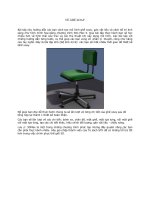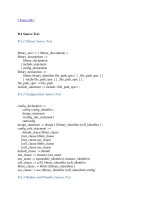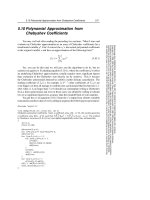Tài liệu Hierarchical Modeling Concepts part 1 pdf
Bạn đang xem bản rút gọn của tài liệu. Xem và tải ngay bản đầy đủ của tài liệu tại đây (26.74 KB, 6 trang )
[ Team LiB ]
2.1 Design Methodologies
There are two basic types of digital design methodologies: a top-down design
methodology and a bottom-up design methodology. In a top-down design methodology,
we define the top-level block and identify the sub-blocks necessary to build the top-level
block. We further subdivide the sub-blocks until we come to leaf cells, which are the
cells that cannot further be divided. Figure 2-1
shows the top-down design process.
Figure 2-1. Top-down Design Methodology
In a bottom-up design methodology, we first identify the building blocks that are
available to us. We build bigger cells, using these building blocks. These cells are then
used for higher-level blocks until we build the top-level block in the design. Figure 2-2
shows the bottom-up design process.
Figure 2-2. Bottom-up Design Methodology
Typically, a combination of top-down and bottom-up flows is used. Design architects
define the specifications of the top-level block. Logic designers decide how the design
should be structured by breaking up the functionality into blocks and sub-blocks. At the
same time, circuit designers are designing optimized circuits for leaf-level cells. They
build higher-level cells by using these leaf cells. The flow meets at an intermediate point
where the switch-level circuit designers have created a library of leaf cells by using
switches, and the logic level designers have designed from top-down until all modules are
defined in terms of leaf cells.
To illustrate these hierarchical modeling concepts, let us consider the design of a negative
edge-triggered 4-bit ripple carry counter described in Section 2.2
, 4-bit Ripple Carry
Counter.
[ Team LiB ]
[ Team LiB ]
2.2 4-bit Ripple Carry Counter
The ripple carry counter shown in Figure 2-3
is made up of negative edge-triggered
toggle flipflops (T_FF). Each of the T_FFs can be made up from negative edge-triggered
D-flipflops (D_FF) and inverters (assuming q_bar output is not available on the D_FF),
as shown in Figure 2-4
.
Figure 2-3. Ripple Carry Counter
Figure 2-4. T-flipflop
Thus, the ripple carry counter is built in a hierarchical fashion by using building blocks.
The diagram for the design hierarchy is shown in Figure 2-5
.
Figure 2-5. Design Hierarchy
In a top-down design methodology, we first have to specify the functionality of the ripple
carry counter, which is the top-level block. Then, we implement the counter with T_FFs.
We build the T_FFs from the D_FF and an additional inverter gate. Thus, we break
bigger blocks into smaller building sub-blocks until we decide that we cannot break up
the blocks any further. A bottom-up methodology flows in the opposite direction. We
combine small building blocks and build bigger blocks; e.g., we could build D_FF from
and and or gates, or we could build a custom D_FF from transistors. Thus, the bottom-up
flow meets the top-down flow at the level of the D_FF.
[ Team LiB ]
[ Team LiB ]
2.3 Modules
We now relate these hierarchical modeling concepts to Verilog. Verilog provides the
concept of a module. A module is the basic building block in Verilog. A module can be
an element or a collection of lower-level design blocks. Typically, elements are grouped
into modules to provide common functionality that is used at many places in the design.
A module provides the necessary functionality to the higher-level block through its port
interface (inputs and outputs), but hides the internal implementation. This allows the
designer to modify module internals without affecting the rest of the design.
In Figure 2-5
, ripple carry counter, T_FF, D_FF are examples of modules. In Verilog, a
module is declared by the keyword module. A corresponding keyword endmodule must
appear at the end of the module definition. Each module must have a module_name,
which is the identifier for the module, and a module_terminal_list, which describes the
input and output terminals of the module.
module <module_name> (<module_terminal_list>);
...
<module internals>
...
...
endmodule
Specifically, the T-flipflop could be defined as a module as follows:
module T_FF (q, clock, reset);
.
.
<functionality of T-flipflop>
.
.
endmodule
Verilog is both a behavioral and a structural language. Internals of each module can be
defined at four levels of abstraction, depending on the needs of the design. The module
behaves identically with the external environment irrespective of the level of abstraction
at which the module is described. The internals of the module are hidden from the
environment. Thus, the level of abstraction to describe a module can be changed without
any change in the environment. These levels will be studied in detail in separate chapters
later in the book. The levels are defined below.
•
Behavioral or algorithmic level
This is the highest level of abstraction provided by Verilog HDL. A module can be
implemented in terms of the desired design algorithm without concern for the
hardware implementation details. Designing at this level is very similar to C
programming.
•
Dataflow level
At this level, the module is designed by specifying the data flow. The designer is
aware of how data flows between hardware registers and how the data is processed
in the design.
•
Gate level
The module is implemented in terms of logic gates and interconnections between
these gates. Design at this level is similar to describing a design in terms of a gate-
level logic diagram.
•
Switch level
This is the lowest level of abstraction provided by Verilog. A module can be
implemented in terms of switches, storage nodes, and the interconnections
between them. Design at this level requires knowledge of switch-level
implementation details.
Verilog allows the designer to mix and match all four levels of abstractions in a design.
In the digital design community, the term register transfer level (RTL) is frequently used
for a Verilog description that uses a combination of behavioral and dataflow constructs
and is acceptable to logic synthesis tools.
If a design contains four modules, Verilog allows each of the modules to be written at a
different level of abstraction. As the design matures, most modules are replaced with
gate-level implementations.
Normally, the higher the level of abstraction, the more flexible and technology-
independent the design. As one goes lower toward switch-level design, the design
becomes technology-dependent and inflexible. A small modification can cause a
significant number of changes in the design. Consider the analogy with C programming
and assembly language programming. It is easier to program in a higher-level language
such as C. The program can be easily ported to any machine. However, if you design at
the assembly level, the program is specific for that machine and cannot be easily ported
to another machine.









